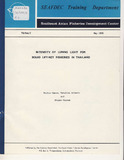Intensity of Luring Light for Squid Lift-Net Fisheries in Thailand
抄録
Net fishing with light has made a great progress in the Gulf of Thailand and as a result, the power of fishing lights has been increasing year by year. However, There is very little information concerning the attracting effects of light in water.
The present paper is a brief report on calculation of light intensity in water by application of a theoretical model about the light of this report, visited the Training Department, SEAFDEC, form 15 or 25 August, 1981, as a short-term expert on fish luring lamp. On his return request, the report has been translated into English and rearranged of the Training Department, SEAFDEC.
Three sets of data wear available for the calculation of fishing light source form the sea level, and transparency of water . Some aspects which affect the light intensity such as the arrangement of lamps on board or the differential sizes of boats wear not taken into consideration. Therefore, more detailed data, such as the attenuation rate of light or actual lumen values which are used the field conditions are necessary for practical purposes, Furthermore, there is a lack of fundamental information of the actual method of operation for catching squid. For example, the depth where the net is shot or the attracting effect of light in conjunction with the behavior of squid responding to light cannot yet be established categorically. Therefore, the present study is limited to the estimation of distribution of light intensity in water.
Collections
Related items
Showing items related by title, author, creator and subject.
-
Large Cast Net and Anchovy Falling Net Fisheries to Economic Development: Survey in Pakklong Sub-district, Pathew District, Chumporn Province
Suanrattanachai, Phattareeya; Petchkamnerd, Jinda; Saraphaivanich, Kongpathai; Kamhongsa, Jirapa; Khunnirong, Baramee (Training Department, Southeast Asian Fisheries Development Center, 2003)Large cast net and anchovy falling net fishing gears are developed and innovative technologies of fishing gears. These gears are more effective than traditional fishing gear types to catch a large volume of squid and anchovy ... -
Shrimp Trawl Fishing Experiment on the Fishing Comparison between Mexican Net and Commercial Net Type
Southeast Asian Fisheries Development Center, Training Department (Training Department, Southeast Asian Fisheries Development Center, 1971-06)The next five years plan (1972-1976) of the fisheries development project, one of the aim to increasing the shrimp production for the local consumption and export, the project should be carried out the two items as ... -
Trend Analysis of Slope Net Depth, According to Flow Condition in Rayong Set-Net
Southeast Asian Fisheries Development Center, Training Department (Training Department, Southeast Asian Fisheries Development Center, 2014)11years have passed since the technology transfer of Japanese‐type SET‐NET to Rayong, Thailand. The daily catch data has been recorded by EMDEC. Before the start of acoustic survey for fish amount and distribution of around ...




